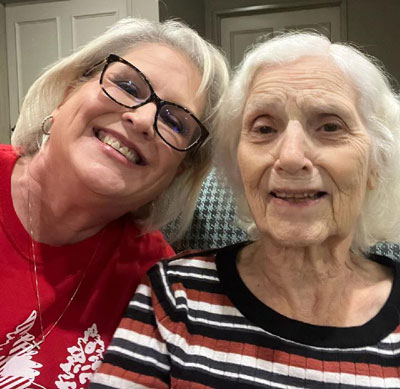Small-house model offers innovative dementia care

Even after she was diagnosed with Alzheimer's in her 80s, Denise McClain's mother-in-law, Agnes, still managed to live alone for several years. But when Agnes started having trouble identifying spoiled food and could no longer clean her house or pay her bills, Denise and other family members knew it was time for a change.
"It was too much for her to function independently," Denise says.
Denise, a registered nurse who spent 13 years working in traditional large-scale nursing homes, advocated for Agnes to live in a small-house model nursing home instead. Traditional nursing homes typically have all residents living under one large community roof inside separate or shared apartments. Small-house nursing homes are licensed as nursing communities, but are set up as a cluster of small self-contained structures that are each occupied by a limited number of residents.
Small-house nursing homes are growing in popularity around the country. Advocates say the model helps promote person-centered care and offers residents more independence and improved quality of life over traditional models.
Denise and her family chose a small-house nursing home for Agnes in Rison, Arkansas, where she now lives with 11 other residents. A former business executive, Agnes, now 95, has her own private bedroom in the home with her own bathroom, a recliner, photos of friends and family, and her favorite papers and magazines.
Agnes also enjoys eating home-cooked meals prepared in the small house's open kitchen, watering plants in the garden and sitting in the large living room in front of the fireplace.
"When she made the move two years ago, it felt very familiar and normal for her," Denise says. "It can be a hard transition for elders who go into an institutional environment. They may have a roommate, and their room is just one of many in a long corridor."

The small-house community where Agnes lives is one of nearly 400 in 33 states nationwide operating under The Green House® Project (GHP), a nonprofit organization working on improving nursing home care through implementation of the small-house model.
"The traditional nursing home model has always focused on efficiency," says Susan Ryan, chief executive officer of the Center for Innovation, the nonprofit parent organization of GHP. "With Green House homes, it's not just about creating small physical environments. It's about deinstitutionalization, destigmatization and humanization. We're shifting the paradigm."
In Green House homes, there's a focus on helping residents thrive both clinically and personally. "Instead of focusing on what a person has lost or can no longer do because of cognitive impairment, we focus on what they've retained," Ryan says.
Needs may change at different stages of Alzheimer's. Deciding on care can be a tough decision, but we can help.
Learn More
Since the nursing homes are small-scale and more individualized, residents have easier access to things like outdoor activities, cooking, pets and visitors. While these activities can increase risk for people living with dementia, Ryan says that it is offset by the physical and emotional benefits.
"We get residents involved in gardening, baking and all other things that portray them as normal adults in a dignified way," Ryan says. "There's a tendency to ‘bubble wrap' people with dementia to keep them safe. Rather than rob people living with dementia of their ability to engage in risk, we prioritize each resident's right as a human to exercise autonomy in making a choice."
For example, residents can go outside unaccompanied because Green House homes have enclosed courtyards. The benefits of mobility outweigh the potential fall risk, Ryan says. "We're not saying we throw safety out the window, but the industry has a history of putting safety first at all costs. As we've learned more, we've done better," she says.
Small-house homes are especially helpful for individuals living with dementia because they provide familiarity. "None of us grow up in institutions. We grow up in homes," Ryan says. "That is so reinforcing to a person's identity and the fabric of family and community."
Small-house homes also provide consistency. In larger nursing homes, rotating staff members typically perform only one or two functions for large groups. In the small-house model, individual staff members are trained to provide a range of duties, including laundry, bathing and cooking, which speed response times and allow residents and their caregivers to build strong relationships. While staff don't live in the homes, they routinely check on residents in shifts and are available 24 hours a day.
The consistency in nursing staff is also a benefit for the family members of people living with dementia. "When I call, I know who to ask for, and I know they know Agnes well," Denise says.
While the benefits of small-house homes are easily apparent, providers looking to expand this model have experienced challenges, including development costs, regulations and workforce challenges. For consumers, obstacles include limited availability and higher costs. While it may cost more for private payers, Ryan says nearly half of Green House residents have used Medicaid to pay for their care.
"Small-house nursing homes are a worldwide movement," says Doug Pace, senior director of Long-Term and Community-Based Care at the Alzheimer's Association. "The Green House Project is the largest formalized initiative that uses the small-house model, but it's not the only one. We hope there will be a great expansion of these types of communities across the country. It's a movement that's just getting started."